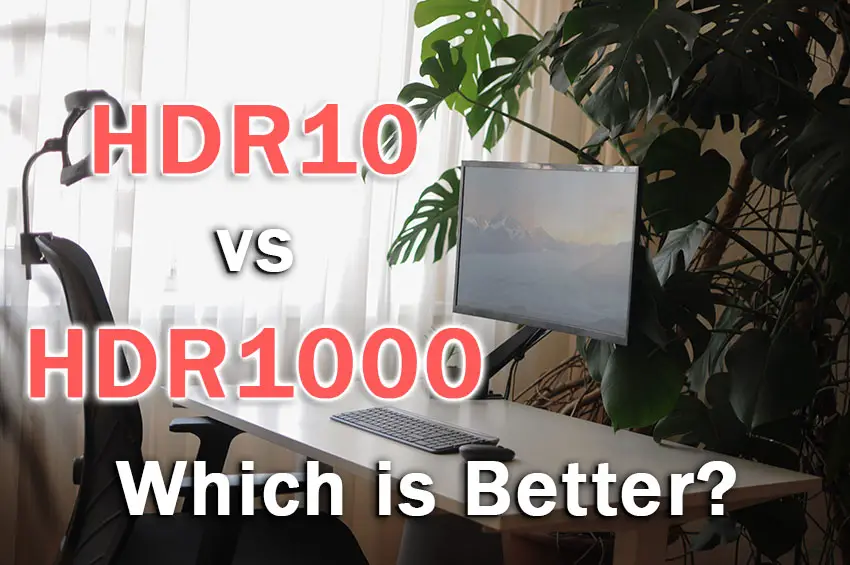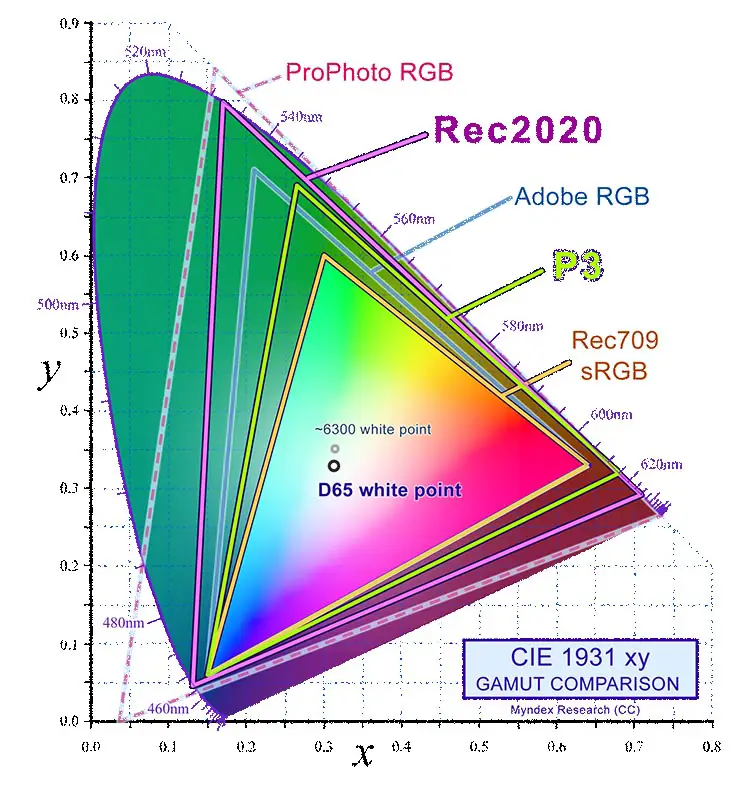When comparing HDR10 vs HDR 1000, the difference is that HDR10 is the base layer specifying 10-bit colors and a specific color gamut of the monitor, while HDR1000 is a sub-standard of the VESA DisplayHDR standard that means a screen supports 1000 nits of peak luminance, plus other technical characteristics which we will cover below.
HDR is known to give a much more detailed image through boosting the dynamic range of what you see on screen.
But the various standards of HDR can be confusing. After all, what does HDR10 and HDR 1000 actually mean, and what is the difference between them?
Both HDR10 and HDR1000 are specfic methods to measure the ability of a monitor or TV to display high dynamic range content, but their actual definitions can vary depending on how the monitor manufacturer interprets these HDR standards.
In this article, we’ll cover what exactly is the difference between HDR1000 vs HDR10, and how you can use this knowledge to be better informed about your next monitor or TV purchase.

What’s the Difference Between HDR10 and HDR1000?
HDR10 is an open-source standard released by the Consumer Electronics Association in 2015, specifiying a wide color gamut and 10-bit color, and is the most widely used of the HDR formats.
It’s a pretty basic format that doesn’t really tell you much, only that the screen is able to display high dyanamic range images, with plenty of detail in darks and lights, and with good contrast. These monitors are very good for photo editing.
The color gamut of an HDR10 screen should follow the Rec. 2020 specification, which is much wider than the DCI-P3 gamut of HDR1000 screens, but of course just because a monitor is following this gamut, doesn’t mean that it is able to display all of its colors.

(Source: Wikimedia Commons)
HDR10 directly competes with HDR10+, which adds dynamic metadata to allow correct dynamic range to be determined by the screen on a frame by frame basis, and Dolby Vision, which is similar to HDR10+, but is a more proprietary format.
HDR1000 is a subset of the DisplayHDR format, an official standard developed and supported by VESA, and is not directly comparable with HDR10, although there is some overlap.
DisplayHDR 1000 as it is more properly known, is targeted to professional monitors and laptops, and specifies that a screen can display a peak luminance of 1000 cd/m2 in a 10% center patch test and flash test, with 600 cd/m2 on a sustained, 30-minute full screen test. You also get local dimming with a 2x increase in contrast over HDR600, and 90% of the DCI-P3 color gamut, plus 10-bit signal processing.
Pretty much every monitor that uses HDR will have HDR10 support, as it is such a wide-ranging standard with no real independent testing to validate manufacturer’s claims, but only a handful will have HDR1000 support, as this is a much more specific, muli-level format that is accredited by VESA.
HDR1000 vs Display HDR1000
Before we look at the full differences between the two specifications, it’s important to separate those screens that are truly hit their HDR standards from those that manufacturers only claim hit these standards, with this being done through carefully reading the marketing terminology used.
On their own, HDR1000 is fairly meaningless. Although you could expect a monitor from this standard to hit 1000 cd/m2 in luminance, you have no idea if this is a sustained test of the whole screen, a partial test of the screen center or a flash test.
Consequently, any screen that is solely described as “HDR1000” might not offer you the performance that you expect, as this terminology means that it has not been independently verified.
The only organisation that is able to properly measure whether a screen hits HDR 1000 is VESA, a non-profit that rigourously tests monitors supplied by manufacturers according to their own specifications.

These specifications are under the DisplayHDR name.
Unfortunately, this is often shortened by consumers to simply “HDR”, meaning that when manufacturers use terms like HDR1000, consumers assume that this means the screen hits the official DisplayHDR1000 standard, when in fact the screen doesn’t.
If, on the other hand, a screen has a VESA certified DisplayHDR 1000 certification (which will be shown in the marketing materials) then it definitely will meet the official standard (although you should watch out for some manufacturers even trying to cheat at this).
This DisplayHDR certification means that a monitor is guaranteed to hit a certain brightness level in both a 10% center patch test, a flash test, and a sustained 30 minute full screen test, plus it also specifies a certain color gamut, global or local dimming, and many other technical criteria.
Therefore, you should always look out for VESA Certified DisplayHDR1000 to ensure that your screen is really hitting the standard, and not a sub-standard made up by a manufacturer.
The Complete Difference Between HDR1000 vs HDR10
Going by the offical definitions of HDR1000 and HDR10, the complete differences between them are:
HDR10 – the Most Basic HDR Standard
- 10-bit imaging
- Follows Rec. 2020 color gamut, although does not specify how much of the gamut a screen should be able to display
- Static HDR metadata that provides info for dynamic range on a per-video basis
Display HDR1000 – for Professional and Enthusiast Monitors
- Max black luminance is half the level of DisplayHDR 600, offering much deeper blacks
- Local dimming offers 2x more contrast than DisplayHDR 600
- Peak luminance of 1000 cd/m2 in 10% center patch test and flash test
- Peak luminance of 600 cd/m2 sustained for 30 minutes over the entire screen
You can learn more about the real-world differences between HDR standards in the video below, but note that it can be difficult to see any differences in a video – you really need to see monitors and TVs that hit these standards in person to really get a feel for the true differnences.
HDR 10 vs HDR 1000 Summary
HDR10 means that the screen can support 10-bit color, but does necessarily make a claim about brightness or color uniformity.
HDR1000 means that the screen can support a minimum peak brightness of 1000 nits and meets other requirements for peak brightness, average brightness, color uniformity and black level.
Read More:
HDR10 vs HDR1000 for Gaming and Real-World Use
Broadly speaking, you might not see a huge amount of difference between screens at the HDR10 and 1000 standards, as these two standards are not mutually exclusive – a monitor can be both HDR 10 and HDR1000 for example, but for more budget manufacturers you will see a significant difference.
Pretty much any entry-level monitor, excluding those at the real budget end, will support HDR10 nowadays. This simply means that they have better dynamic range and contrast than older, non-HDR monitors, but their performance is variable depending on the manufacturer.

HDR 1000 monitors on the other hand, provided they have been verfied by VESA, have very high, provable performance related to color gamut, peak luminance and black point, among many other smaller technical details.
However, if you are gaming, then the extra contrast, improved local dimming and more detail visible in the darkest areas will likely be reason enough for you to look at HDR1000 monitors.
HDR1000 allows for a much more natural image to be produced, although note that your game will have to support the DisplayHDR standard in order to see the best performance from your screen.
It will still work fine when used with software not tuned to VESA’s standards, but lacks a noticeable edge in performance that you get with fully optimized software.
Read More:
Horizontal lines on Vizio TV Screen? Try this…
What’s the best resolution for a 32 inch monitor?


![What is the Best Drawing Tablet for Photoshop? [TESTED]](https://www.lapseoftheshutter.com/wp-content/uploads/2020/06/best-drawing-tablets-for-photoshop-340x226.jpg)



2 Responses
Jess
I can’t find any HDR 1000 monitors in the 21″-24″ range. They are all either smaller, 15.6″ or larger 27″. Nothing in the middle. Do you know of any that are 21″-24″?
Tim Daniels
I’ve had a quick look and I can’t find any below 27″.
I guess most people just don’t want HDR1000 in smaller sizes.